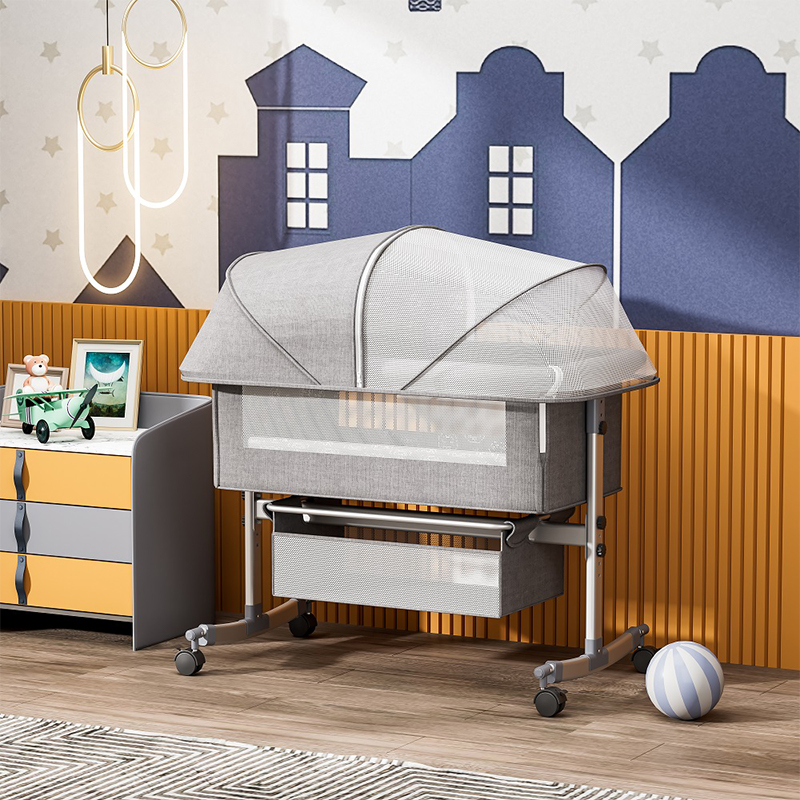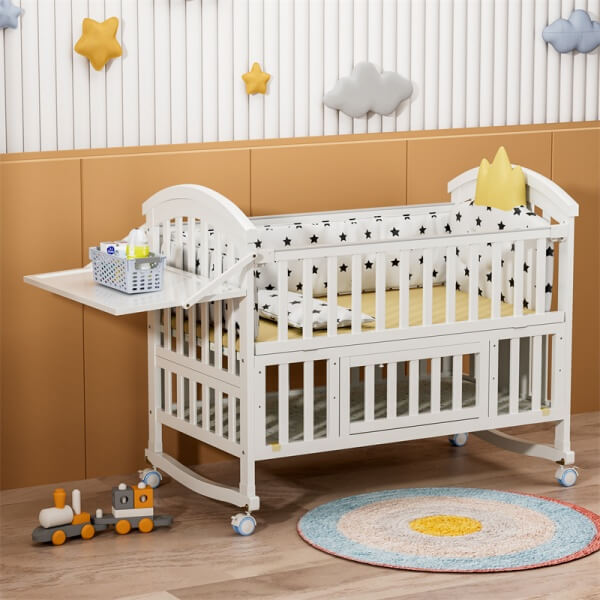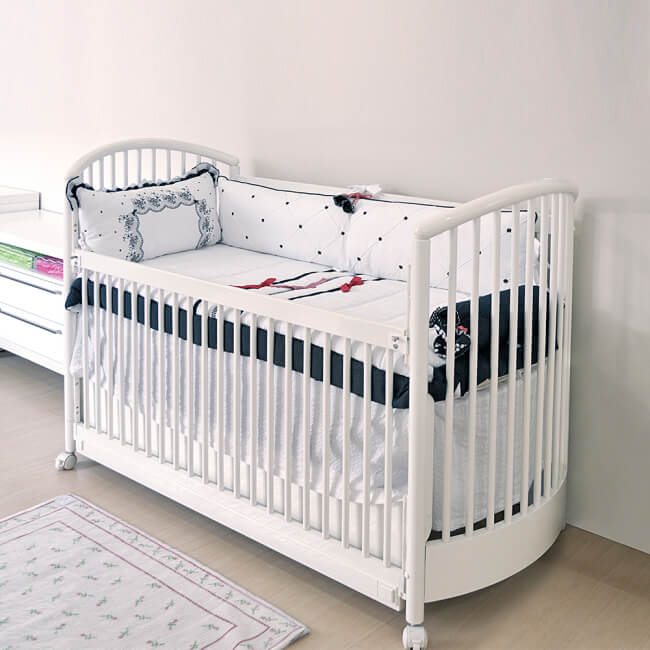En tant que parent nourricier, voir votre nouveau-né chérubin sombrer dans un sommeil paisible est un spectacle qui réchauffe le cœur. Cependant, le chemin vers une croissance constante berceau Le sommeil peut être semé d'embûches. N'ayez crainte, ce guide complet vous fournira une multitude de stratégies pour amener doucement votre tout-petit à adopter le berceau comme son havre de paix.
Comprendre les habitudes de sommeil des nouveau-nés
Les bases des cycles de sommeil du nouveau-né
Les nouveau-nés ont des cycles de sommeil différents de ceux des adultes, souvent caractérisés par des périodes de sommeil plus courtes et des réveils plus fréquents. Leurs cycles de sommeil durent généralement entre 50 et 60 minutes, et comprennent à la fois des phases de sommeil actif (REM) et de sommeil calme (non REM).
Différences entre le sommeil diurne et nocturne
Au début, les nouveau-nés ne font pas la différence entre le jour et la nuit, ce qui entraîne des troubles du sommeil. Il est fréquent qu'ils soient plus éveillés la nuit, ce qui peut être difficile pour les parents.
Les nouveau-nés ont des habitudes de sommeil uniques qui peuvent être difficiles à gérer pour les nouveaux parents. Il est essentiel de comprendre ces habitudes et ces besoins de sommeil pour aider les nouveau-nés à s'habituer à dormir dans un berceau. Avec de la patience, de la cohérence et quelques stratégies, les parents peuvent aider leurs nouveau-nés à se sentir plus à l'aise et à s'adapter au sommeil dans un berceau.
Pourquoi certains nouveau-nés ne dorment pas dans des berceaux ?
Les bébés aiment la proximité
Les nouveau-nés ont un fort besoin de proximité physique et de confort. Ils se sentent plus en sécurité et réconfortés lorsqu'ils dorment en contact étroit avec leurs parents. Il n'y a pas d'endroit plus confortable pour votre nouveau-né que la chaleur de vos bras aimants. Cependant, cette préférence peut créer par inadvertance une association de sommeil qui rend son sommeil dans le berceau une tâche ardue.
Un environnement inconnu peut mettre le bébé mal à l'aise
Le berceau peut être un environnement inconnu et inconfortable pour le nouveau-né, habitué à la chaleur et à la sécurité du ventre maternel ou des bras de ses parents. Cette transition peut rendre le bébé mal à l'aise et agité.
Problèmes de gaz et de reflux
Les problèmes digestifs comme les gaz ou le reflux acide peuvent transformer le simple fait de s'allonger en une épreuve pénible pour votre tout-petit. Alors qu'il doit faire face à ces désagréments, la perspective de s'endormir paisiblement dans son berceau devient un rêve lointain.
Si votre tout-petit souffre de gaz ou de reflux acide, des ajustements à sa routine d'alimentation et à son positionnement peuvent faire des merveilles. Pensez à le maintenir en position verticale pendant 20 à 30 minutes après les repas, à le faire roter fréquemment et à essayer des techniques de massage douces pour soulager l'inconfort avant d'essayer de dormir dans un berceau.
Les bébés sont sujets au réflexe de sursaut
Imaginez-vous être réveillé en sursaut à chaque fois que vous êtes installé dans votre lit douillet. C'est la réalité des nouveau-nés qui ont le réflexe de sursaut. Cette réaction innée, déclenchée par des mouvements brusques ou des bruits forts, peut instantanément réveiller votre bébé de son sommeil, le laissant les yeux écarquillés et déconcerté.
Environnement de sommeil inconfortable
Imaginez-vous en train de tenter de dormir sur une surface impitoyable ou au milieu d'une chaleur étouffante. C'est une bataille difficile, n'est-ce pas ? Les nouveau-nés, avec leurs sens délicats, sont tout aussi sensibles à l'inconfort provenant de diverses sources. Un matelas mal ajusté, des tissus qui grattent ou une mauvaise régulation de la température peuvent tous contribuer à leur malaise, ce qui les empêche de s'endormir de manière réparatrice.
Le bébé est trop fatigué
Paradoxalement, un bébé trop fatigué peut résister plus violemment au sommeil qu'un bébé bien reposé. Lorsque son horloge interne se dérègle, ses hormones de stress augmentent, ce qui fait qu'il a de plus en plus de mal à s'installer et à profiter de l'étreinte apaisante du berceau.
Il est essentiel de reconnaître les signes de fatigue excessive, car les détecter tôt peut éviter une spirale descendante vers la résistance. Voici quelques signes courants du sommeil :
- Le bâillement : l’un des signes les plus reconnaissables.
- Se frotter les yeux ou les oreilles : les bébés se frottent souvent les yeux ou les oreilles lorsqu’ils sont fatigués.
- Diminution de l’activité : Ralentissement ou diminution de l’intérêt pour le jeu.
- Regarder dans le vide : regarder dans le vide ou paraître moins engagé.
- Agitation : devenir plus irritable ou grincheux.
- Adhérence : désir d’être tenu plus que d’habitude.
- Sucer les doigts ou la tétine : besoin accru de téter pour se réconforter.
- Pleurs : Agitation croissante menant aux pleurs.
- Perte d’intérêt pour les personnes ou les jouets : se détourner des stimuli.
- Mouvements saccadés : les bras et les jambes bougent de manière plus erratique.
- Fouiller : les nouveau-nés peuvent commencer à fouir ou à chercher un sein ou un biberon même s’ils n’ont pas faim.
- Plus silencieux : devenir plus silencieux et moins actif.
- Paupières tombantes : les paupières peuvent commencer à tomber ou le patient peut avoir du mal à garder les yeux ouverts.
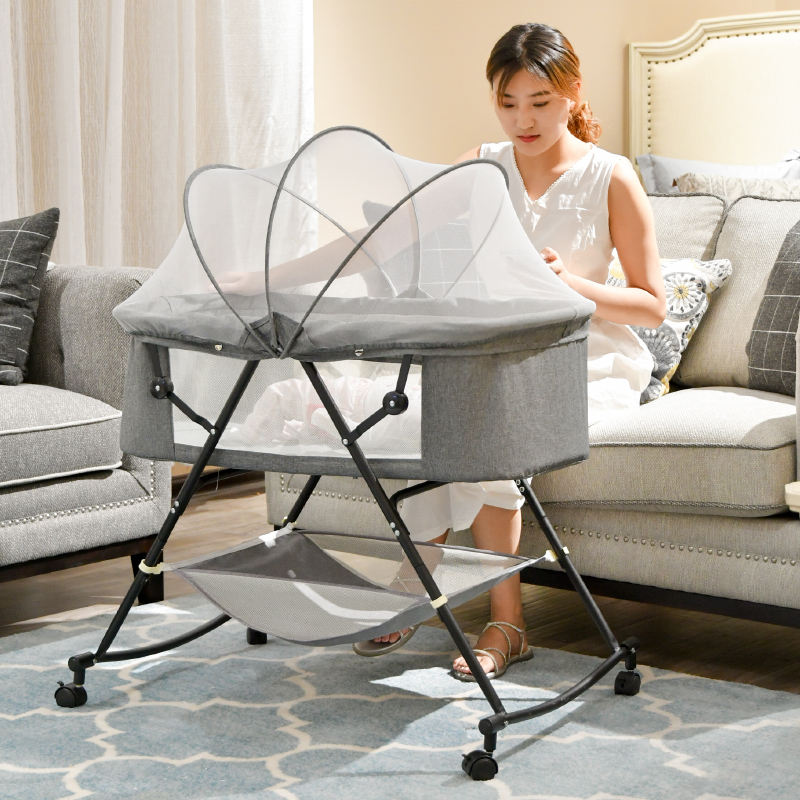
Comment faire dormir un nouveau-né dans son berceau
Créez un environnement propice au sommeil
1. Emmaillotage : Emmaillotez votre bébé pour imiter la sensation de confort de l'utérus. Cela peut éviter le réflexe de sursaut qui réveille souvent les nouveau-nés. Utilisez une couverture légère et respirante et assurez-vous qu'elle est bien ajustée, mais pas trop serrée autour des hanches.
2. Bruit blanc : Utilisez une machine à bruit blanc ou une application pour imiter les bruits de l’utérus. Les nouveau-nés sont habitués au bruit constant du flux sanguin dans l’utérus, qui est similaire au bruit blanc. L’utilisation d’une machine à bruit blanc ou d’un ventilateur peut aider à créer un environnement familier et apaisant qui bloque les bruits soudains qui pourraient les surprendre.
3. Éclairage tamisé : Gardez la pièce sombre ou tamisée pour signaler à votre bébé qu'il est l'heure de dormir. Éviter les lumières vives aide à maintenir son rythme circadien et favorise la production de mélatonine, l'hormone du sommeil.
4. Température ambiante : Assurez-vous que la température de la pièce est confortable, généralement entre 20 et 22 °C (68 et 72 °F). Habillez votre bébé avec des vêtements appropriés et utilisez des couvertures légères ou des gigoteuses.
Profitez du cycle de sommeil naturel de bébé
Soyez attentif aux signes de sommeil de votre bébé, comme les bâillements, les frottements des yeux ou l'irritabilité. Les pleurs peuvent également être un signe tardif de fatigue. Il est préférable d'agir en fonction des signes précoces pour éviter que votre bébé ne soit trop fatigué, ce qui peut l'empêcher de s'endormir.
Connaître les fenêtres d'éveil de votre bébé (le temps pendant lequel il peut rester éveillé confortablement entre deux siestes) peut vous aider à prévenir la fatigue excessive. Les nouveau-nés ont généralement de courtes fenêtres d'éveil de 45 minutes à une heure et demie. Surveillez l'heure à laquelle votre bébé se réveille et essayez de commencer la routine de sommeil dans sa fenêtre d'éveil.
Établissez une routine pour l'heure du coucher
1. Synchronisation cohérente : L'instauration d'une routine de coucher régulière à la même heure chaque soir permet de signaler à votre bébé qu'il est temps de se détendre et de se préparer à dormir. Cette régularité aide à réguler son horloge interne.
2. Activités : Incluez des activités apaisantes comme un bain chaud, un massage doux, des berceuses douces ou la lecture d’un petit livre. Ces activités doivent être prévisibles et apaisantes, créer un sentiment de sécurité et aider le bébé à se détendre.
Maîtriser de bonnes techniques d'apaisement
1. Balancer et tapoter : Un léger balancement ou des caresses peuvent aider à calmer un bébé agité. Vous pouvez le faire en tenant votre bébé dans vos bras et en le balançant d'avant en arrière ou en utilisant une chaise à bascule.
2. Sucette : L'utilisation d'une tétine peut aider à satisfaire le réflexe naturel de succion du bébé et lui procurer du réconfort. Elle peut apporter du réconfort et aider votre bébé à s'endormir sans se nourrir.
3. Massage pour bébé : Un massage doux pour bébé peut aider à détendre les muscles de votre bébé et à calmer son système nerveux. Effectuez des mouvements doux et rythmés avec un peu de lotion ou d'huile sans danger pour bébé.
4. Roter : Assurez-vous de faire roter votre bébé après l'avoir nourri pour libérer l'air emprisonné. Cela peut éviter l'inconfort et réduire l'irritabilité due aux gaz.
5. Utilisez votre voix : Parler doucement ou chanter une berceuse peut être très apaisant pour un nouveau-né. Le son de votre voix lui est familier et réconfortant.
6. Alimentation : Parfois, une tétée suffit à calmer un nouveau-né. Assurez-vous que votre bébé est bien nourri avant d'essayer de le coucher. Veillez à ne pas le laisser s'endormir au sein ou au biberon, car cela pourrait créer une dépendance.
Donnez à votre bébé une chance de s’apaiser
L’importance de l’auto-apaisement pour les bébés
Même s'il peut être tentant de se précipiter aux côtés de votre bébé dès les premiers gémissements ou pleurs, lui donner la possibilité de s'apaiser peut être une compétence précieuse pour vous et votre tout-petit. Cependant, ce processus nécessite de la patience, de la cohérence et une approche douce.
Les bébés qui savent se calmer seuls sont capables de s’endormir seuls sans avoir besoin de l’intervention constante des parents. Cela peut conduire à de meilleures habitudes de sommeil et à des périodes de sommeil ininterrompues plus longues. Lorsque les bébés peuvent se calmer seuls pour se rendormir, ils sont moins susceptibles de se réveiller complètement lors de brefs réveils nocturnes. Cela signifie moins de perturbations nocturnes pour le bébé et les parents.
Méthodes détaillées
Si vous le bercez ou le nourrissez toujours pour l’endormir, il s’attendra à ce que cela se produise à chaque fois qu’il se réveillera. Essayez plutôt de le réconforter avec un minimum d’intervention et donnez-lui la possibilité de s’endormir tout seul. Placez votre bébé dans le berceau ou le lit lorsqu’il est somnolent mais toujours éveillé. Cela lui permet d’associer l’environnement de sommeil au processus d’endormissement, plutôt que d’avoir besoin d’être bercé ou nourri pour s’endormir.
Si votre bébé commence à s'agiter, attendez quelques minutes avant d'intervenir. Il peut parfois se rendormir tout seul. Si vous devez intervenir, faites-le brièvement, puis reculez pour lui donner une autre chance. Si votre bébé a du mal à s'endormir, rassurez-le en lui parlant doucement ou en le tapotant doucement pendant qu'il est dans le berceau. Évitez de le prendre immédiatement dans vos bras, car cela peut renforcer la dépendance au fait d'être tenu dans vos bras pour dormir.
Réduisez progressivement votre présence à mesure que votre bébé apprend à s'apaiser tout seul. Commencez par rester à proximité et réconfortez-le avec votre voix ou un léger contact, puis diminuez progressivement le nombre d'interventions au fil du temps.
Donnez à votre bébé douceur et patience
Faire dormir son enfant dans un berceau peut être un processus difficile, surtout pour les nouveaux parents qui cherchent encore leur voie. Ce parcours nécessite beaucoup de tendresse et de patience, car votre enfant apprend à s'habituer à dormir seul dans un berceau. Il est essentiel de comprendre que cette période d'adaptation n'est pas courte et que votre approche douce et patiente jouera un rôle crucial pour aider votre enfant à se sentir en sécurité et à l'aise.
Les bébés ont leurs propres habitudes de sommeil et il est normal qu'ils résistent aux nouvelles habitudes de sommeil au début. S'attendre à des résultats immédiats peut être source de frustration, mais comprendre que votre bébé a besoin de temps pour s'adapter peut vous aider à rester calme et à le soutenir. Il y aura des nuits de réveils fréquents et des moments d'agitation, mais garder un comportement patient montre à votre bébé que vous êtes là pour lui, peu importe le temps que cela prend.
Comment rendre le berceau plus confortable ?
Literie douce et respirante : Utilisez un matelas ferme et respirant et une literie douce et respirante comme des draps en coton ou en mousseline.
Balancement doux ou vibration : Quelques berceaux à bascule disposent de fonctions de balancement ou de vibration intégrées qui peuvent aider à apaiser le nouveau-né et favoriser le sommeil.
Aides au positionnement : Utilisez des aides au positionnement comme une cale ou une couverture enroulée pour surélever doucement la tête et le haut du corps du nouveau-né, ce qui peut aider en cas de reflux ou de congestion.
Parfums familiers : Placez un petit objet doux avec l’odeur du parent dans le berceau pour aider le nouveau-né à se sentir plus à l’aise et en sécurité.
Considérations de sécurité lors de l'utilisation d'un berceau pour le sommeil du nouveau-né
Assemblage correct du berceau : Assurez-vous que le berceau est correctement assemblé et que tous les dispositifs de sécurité, tels que le mécanisme de verrouillage, fonctionnent correctement.
Positionnement : Placez toujours le nouveau-né sur le dos pour dormir, jamais sur le côté ou sur le ventre.
Aucun article en vrac : Retirez tous les objets non fixés, tels que les jouets, les oreillers ou les couvertures, qui pourraient présenter un risque de suffocation ou d’étranglement.
Stabilité du berceau : Assurez-vous que le berceau est placé sur une surface stable. Il ne doit pas vaciller ou basculer facilement. Si le berceau est équipé de roulettes, assurez-vous qu'elles sont verrouillées lorsque le berceau est immobile.
Débit d'air : Assurez-vous que le berceau est suffisamment aéré et qu'il n'est pas placé de manière à restreindre la circulation de l'air. Choisissez un berceau avec des côtés en filet respirant. Évitez les berceaux avec des côtés rembourrés, semblables à des oreillers, car ils peuvent présenter un risque d'étouffement si votre bébé roule dedans.
Respecter les limites de poids et d'âge : Adhérer à la fabricant de berceaux Limites de poids et d'âge pour le berceau. La plupart des berceaux sont conçus pour des bébés pesant jusqu'à 15 à 20 livres.
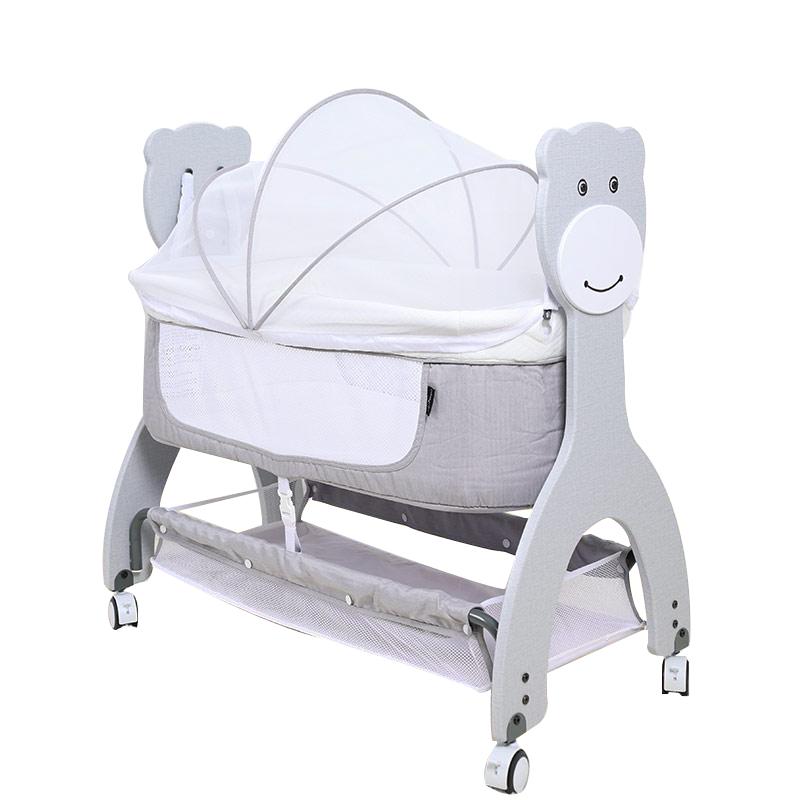
Choisir le bon berceau pour votre nouveau-né
En plus de mettre en œuvre les techniques et les recommandations de sécurité susmentionnées, vous pouvez accélérer la transition de votre bébé vers un sommeil indépendant dans le berceau en lui achetant un berceau confortable et sécurisé. Un berceau de haute qualité offre non seulement du confort à votre bébé, mais permet également aux parents d'économiser de l'énergie et du temps lorsqu'ils apprennent à leur tout-petit à dormir dans le berceau. Voici un guide détaillé sur la façon de choisir le berceau parfait pour votre enfant :
1. Le berceau doit répondre aux normes de sécurité
Vérifiez que le berceau répond aux normes de sécurité établies par des organismes réputés tels que la Consumer Product Safety Commission (CPSC) ou la Juvenile Products Manufacturers Association (JPMA). Ces certifications garantissent que le berceau a passé avec succès des tests de sécurité rigoureux.
Optez pour un berceau doté de parois latérales en filet respirant. Les parois latérales en filet assurent une bonne circulation de l'air, réduisant ainsi le risque d'étouffement et aidant à réguler la température de votre bébé.
2. Choisissez une option de portabilité si nécessaire
Si vous devez déplacer le berceau d’une pièce à l’autre, choisissez-en un qui soit léger et doté de roues ou de poignées pour une portabilité aisée.
3. Équilibrez la taille et l'espace
Mesurez la zone où vous prévoyez de placer le berceau pour vous assurer qu'il s'adapte confortablement. Si vous avez un espace limité, recherchez un petit berceau qui offre néanmoins suffisamment de place pour que votre bébé puisse dormir en toute sécurité.
4. Concentrez-vous sur les fonctionnalités supplémentaires
Certains berceaux sont dotés de fonctionnalités supplémentaires telles que des poches de rangement, des réglages de vibration, des mécanismes de bascule ou des machines à bruit blanc intégrées. Bien que ces éléments ne soient pas essentiels, ils peuvent apporter commodité et confort.
5. Types de berceaux populaires
- Berceaux traditionnels : Berceaux autonomes qui sont généralement légers et peuvent inclure des fonctionnalités telles que des paniers de rangement.
- Berceaux cododo: Se fixe sur le côté du lit des parents, ce qui facilite les tétées nocturnes tout en offrant un espace de sommeil séparé pour le bébé, ce qui en fait une excellente option pour les mères qui allaitent.
- Berceaux de voyage : options légères et portables conçues pour un montage et un démontage faciles, idéales pour les familles qui voyagent fréquemment.
- Berceaux intelligents : équipés de technologies telles que le balancement automatique, le bruit blanc et les capteurs de mouvement pour apaiser bébé et le rendormir automatiquement.
FAQ
Q : Comment puis-je faire en sorte que mon nouveau-né dorme plus longtemps la nuit ?
A : Établissez une routine de coucher cohérente, assurez-vous qu’ils sont bien nourris et créez un environnement de sommeil calme pour encourager des périodes de sommeil plus longues.
Q : Est-il sécuritaire de laisser mon nouveau-né dormir dans le berceau toute la nuit ?
R : Oui, tant que le berceau répond aux normes et directives de sécurité, votre nouveau-né peut dormir dans le berceau toute la nuit en toute sécurité.
Q : Comment puis-je faire passer mon bébé du berceau au lit à barreaux ?
R : Faites une transition graduelle en commençant par des siestes dans le berceau, puis en passant au sommeil nocturne une fois que votre bébé est à l’aise.
Q : Que se passe-t-il si mon bébé ne dort que lorsqu’on le tient dans ses bras ?
A : Essayez de créer une routine de sommeil cohérente et faites progressivement passer votre bébé au sommeil dans le berceau en le couchant somnolent mais éveillé.
Q : À quelle fréquence dois-je vérifier mon nouveau-né pendant la nuit ?
R : Au début, des contrôles fréquents sont courants, mais à mesure que vous et votre bébé vous sentez plus à l’aise, vous pouvez réduire progressivement la fréquence, en vous assurant qu’ils sont sains et saufs.
Conclusion
Aider un nouveau-né à dormir dans son berceau demande de la patience, de la constance et une approche calme. N'oubliez pas que le voyage n'est pas un sprint mais un marathon et que chaque bébé progresse à son propre rythme. Avec de la patience, de la constance et une approche attentionnée, vous et votre tout-petit finirez par trouver votre rythme et le berceau deviendra un havre de paix et de sommeil précieux.
Articles connexes recommandés :

